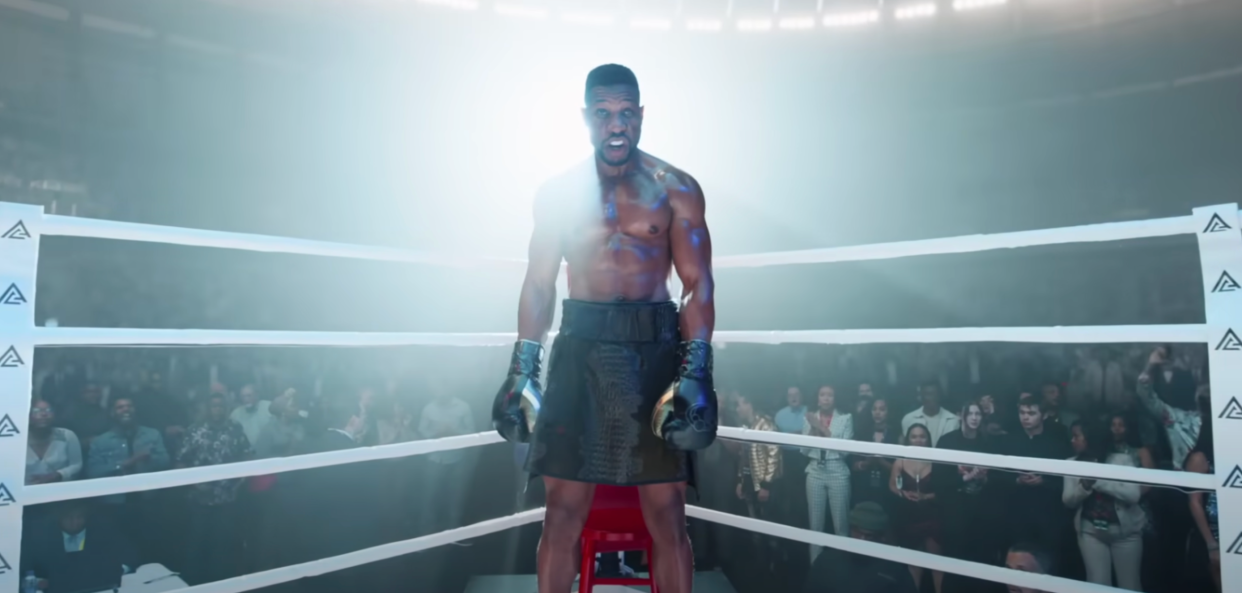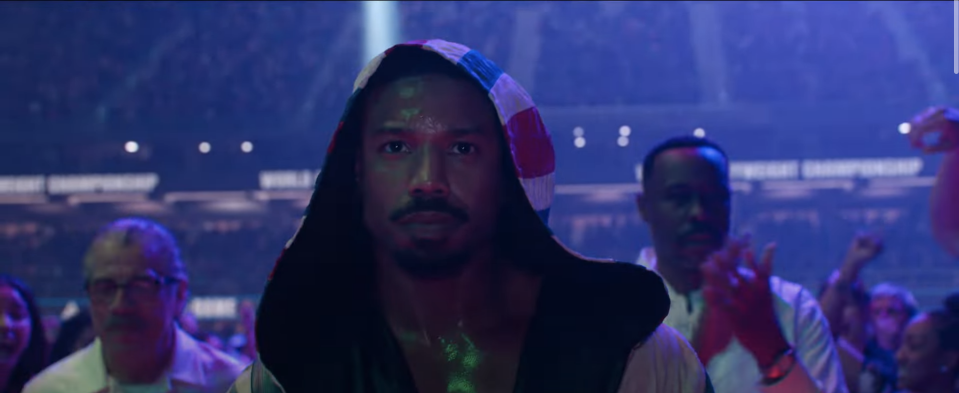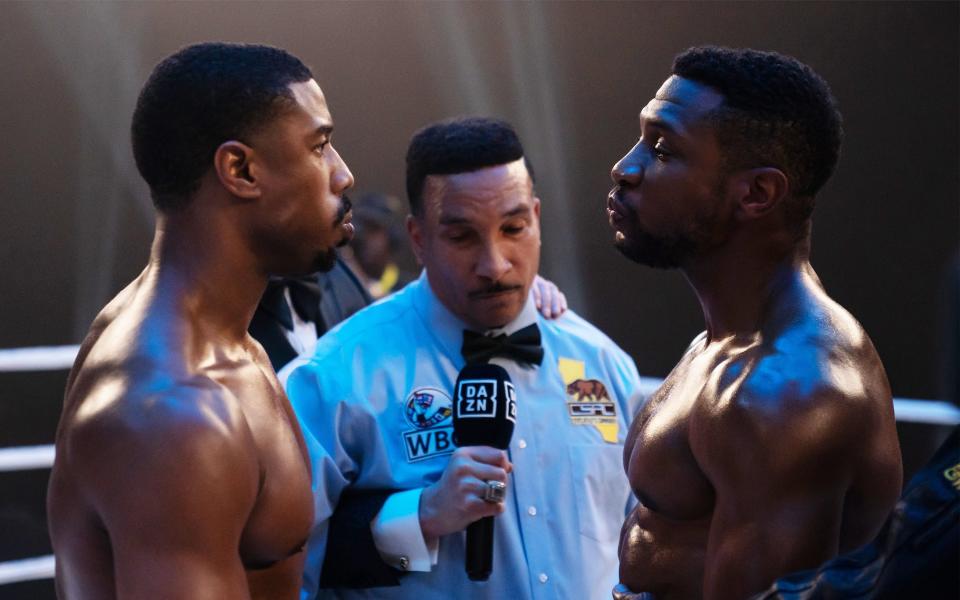How Michael B. Jordan’s Love of Anime Shaped ‘Creed III’ Fight Scenes

- Oops!Something went wrong.Please try again later.
- Oops!Something went wrong.Please try again later.
- Oops!Something went wrong.Please try again later.
There’s always more going on in a boxing ring than just the punches thrown. Action movies in general, and boxing movies especially, offer characters extreme physical challenges and use cinematic tools to express their internal struggles. For example, when the first “Creed” film holds back on using the iconic “Rocky” theme until the 12th round of the final fight, that’s director Ryan Coogler using the language of the “Rocky” movies to show how valiant Adonis Creed is.
For “Creed III,” Michael B. Jordan, the franchise’s star who took on directing duties for the first time, had a new language that he wanted to bring the story of how Adonis, at the peak of his fighting powers, confronts the violence of his past: anime.
More from IndieWire
'Creed III' Starts March with a KO and Another (Jonathan) Majors Success
Tessa Thompson Knew She Had to Work with Jonathan Majors After Seeing His Sundance Debut
Jordan has been a long-time anime fan, both of the style and the kinds of stories embraced by Japanese animation. “I love the themes of anime, culturally, what they say about the bonds of friendships, betrayal, revenge, promises,” Jordan told IndieWire during a recent interview. The first-time director also saw a very clear connection with how he views the story of his character. “Usually the hero is an outcast or, something’s a little off about him, and he has to overcome all odds with every fiber of his being. But he’s the chosen one,” he said.
Japanese anime series, no matter whether they’re dealing in supernatural fantasy or high school (or both), have a heightened emotionality that is similar to the way Adonis fights, which is always about more than the scorecard. This comes with a particular way that time moves in an anime fight, slowing down and isolating particular parts of the body to show the fighters’ thought process, or having whole character exchanges take place in the wind-up to a punch. For “Creed III,” Jordan used his camera to construct a similar time-slowed sense of a fight as a chess match.
“I needed to show the smarts of Adonis. I wanted to see how evolved he was in the beginning of the movie. You know, he’s at the top of his game. He’s boxing on another level. I thought that was really important to establish right off the top,” said Jordan. “I love the thought process of anime, the internal dialog, and seeing the world through how [characters] think. They just achieve a level of action that live action just sometimes doesn’t give you.”
Listen to our entire interview with Michael B. Jordan below. To hear this and more conversations with your favorite TV and film creators, subscribe to the Toolkit podcast via Apple Podcasts, Pocket Casts, Spotify, or Overcast.
Usually, boxing movies use the dialogue of the announcer, or our hero’s corner man, to lead the audience – shouting out which parts of the opponent’s body are vulnerable or advising on what punches to throw. It supplies insight and exposition that points the audience toward what to anticipate and gives the boxing scenes a sense of momentum.
But “Creed III” instead uses extreme close-ups and a moving camera that changes speed dramatically to let us see Adonis’ first fight through his eyes. Jordan establishes a wordless internal dialogue for the champion, designed to echo the actual internal dialogue of anime heroes like Naruto and Goku.
This allows Jordan to introduce Damien Anderson (Jonathan Majors), Adonis’ best friend from childhood, who is now determined to take Adonis’ spotlight for himself. Damien is Adonis’ physical and intellectual equal, possessing the same pin-point vision, which is brought to life by how it guides the camera’s movement like an extension of his mind’s eye.

Screenshot/Youtube
“I wanted it to be a violent ballet,” Jordan said of how Adonis and Damien fight each other. To accomplish this, he turned to Masashi Kishimoto’s 20-year-old anime series “Naruto” for guidance. “I wanted it to feel very emotional, like it’s just them. It’s just the two of them. It’s kind of like in ‘Naruto’ when you go inside of Naruto where the Ninetails Fox is sealed. It’s a void,” he said. “On the outside, he’s going through something that’s physically excruciating. He’s in the middle of the battle. But internally, they’re someplace where they’re talking calmly and they’re having an emotional conversation about how they feel.”
The marquee fight between Adonis and Damien utilizes more than a few anime flourishes, from having the crowd ringside actually fall away and giving the boxers a void in which to see each other as both the boys they were and the men they’ve become. The kind of punches Adonis and Damien throw at each other aren’t quick, sharp hits either. They’re primal, body-shaking things, and Jordan, no less than the animators at Toei behind “Dragon Ball Z,” takes time to show the sweat spray ripped from their bodies that hovers in the air, like tears.
Capturing the film’s anime moments required a variety of approaches to shooting and a variety of cameras. “[The fights are] really a visceral experience where you really feel like you’re part of this fight and also feels hyper sharp and hyper-real, which is quite different than dramatic scenes [shot with the Sony Venice],” cinematographer Kramer Morgenthau told IndieWire. “We used the Phantom, which is a military, industrial camera that was adapted for cinema, and it does ultra slow motion and then you can ramp it around.”
The Phantom is responsible for that “DBZ” back-spray moment, but Jordan and Morgenthau also relied on the Bolt, a high-speed robotic arm that can move a camera faster than a human arm and with programmable precision, to capture the violent ballet of movement in the ring. “There’s a lot of reasons why people don’t want to use the Bolt because there is a danger factor. Once it starts, it can’t stop, and it won’t be able to stop quick enough and you have to have pin-point precision each time. You cannot miss your mark or it’s going to clean your clock pretty well,” Jordan said. “So I love that challenge because I felt like, hey, it’s me in the ring. You know? So if anything, it’s going to be on me to land and hit my marks the way I need to.”

MGM
Morgenthau also employed RED’s Raptor camera which, when used in “fighter” mode, is held like a smaller SLR camera. “Michael even operated some of those shots himself,” Morgenthau said. “That really gave us the boxer’s point of view. You can punch the lens as well. It’s shocking when it’s ripping around. Then there’s punch cams where they’re literally punching the lens and we have rigs to take those hits.”
All the different tools used in the film add up to a particularly Creed way of seeing the boxing ring, and understanding what the fights mean to him. Through extreme close-ups, canted angles, and stylized, over-cranked shots, the film creates this “poetic quality of the images where they don’t have to be linear,” Morgenthau said.
It’s in this poetic space, a void in the middle of everything that’s happening, where Jordan gets to play out Adonis and Damien’s relationship. “I thought that was the perfect kind of like world to take Adonis and Damien to,” he said. “Because it wasn’t about anybody else. I wanted to see if I could make it feel like it was just two brothers that had to go settle some shit.”
MGM will release “Creed III” in theaters on Friday, March 3.
Best of IndieWire
New Movies: Release Calendar for March 3, Plus Where to Watch the Latest Films
Quentin Tarantino's Favorite Movies: 50 Films the Director Wants You to See
Sundance 2023 Movie Deals So Far: NEXT Sci-Fi 'Divinity' with Stephen Dorff Lands Worldwide Deal
Sign up for Indiewire's Newsletter. For the latest news, follow us on Facebook, Twitter, and Instagram.

